
|
|
25 June, 1999
THURSDAY, JUNE 25th 1999
CONTENTS: answering questions
PICTURES: edible parts of whales/arctic cod/ARF(Arctic Research Facility)
HI all! Today was another day of surveying plots of land for Steller's
eiders. We have a big aerial map on the wall in the building we sleep in -
the ARF (Arctic Research Facility), and we have been highlighting all of the
places we have looked. We only have 3 plots of land to left to look in, so we
should be finished by tomorrow night (Friday). Some of the survey crew will
then be on the next plane bound for home in the morning, and most everyone
will be gone by Monday. When we are talking about the plots of land we have
left to cover, people have come up with creative names to call them according
to what they look like from an aerial photo. They have been named things like
"The big red brain", "the amoeba", and "peanut lake". Today I had a piece of
land to look at that has been nicknamed "Norway" for the shape of its
boundaries. Let me tell you, it felt like I walked across the REAL Norway in
hipwaders today! :-D.
Again, I have some good questions to answer:
FROM JERMAINE: What kind of food do you eat?
-------Well, for breakfast, I have been mostly eating cheerios and bananas.
There is a rule at the ARF (Arctic Research Facility - see picture below) that
you must clean up as soon as you finish eating - no leaving dishes around.
So, most of us try and keep the number of dishes we use down to a minimum! We
also have to conserve water, so it is good not to have a lot of dishes to
wash. We are careful to turn off the water to scrub the dishes, and to turn
off the water while we are soaping up in the shower, too.
For lunch, we eat out on the tundra somewhere while we are searching for
the eiders. So, I make a peanut butter and jelly sandwich, and have a ziploc
baggie full of crackers, carrots, a granola bar, and of course, chocolate. It
is also very important to have lots of water along; it's really dry out there!
For dinner, usually one or 2 people make the meal, and it switches every
night. Tonight was chili, and last night was burritos. Of course, like I
mentioned before, the big thing to eat at this time of year is whale (See
pictures below). People who are allowed to hunt whale for subsistence
(Eskimos, Aleuts, Indians) eat about every part of the whale - the blubber,
the meat, the skin, the tongue... - and they eat it raw, cooked, fermented, or
barbecued. The festivals, called naluqataks, are a time when the whales are
given by the whaling crews to the whole community. Anyone who is there can
take as much as they want, and freeze it for eating all year long.
FROM JUSTIN: Have you gone fishing? Have you ate any halibut?
------- Nope, I haven't gotten to go fishing, but I would really like to! The
ice is just breaking up over the ocean, so I don't know if I will get the
chance. The only fish I have eaten here is salmon, which is delicious. Many
people in Alaska smoke their own salmon -- it is making me hungry just writing
about it! You reminded me of this great picture that David Koester, who just
left Barrow, took (see below). It is of an arctic cod that just happened to
be swimming by a hole that Dave had drilled in the ice to take tide
measurements. It stared up at him long enough for Dave to get his camera out
and take a picture! Anyway, I haven't gone out of my way to find seafood
since I love the fish in Hawaii, and it is really expensive up here.
Sometimes you might hear of population decline or even extinctions of
salmon in the Pacific Northwest. In Alaska this is not usually a problem,
even though Alaska accounts for 95% of the US commerical landings of Pacific
Salmon (Alaska Almanac, 21st edition, Alaska Northwest Books). However, there
is the possibility that Alaska's fisheries could face the biological
devestation of some species like has happened on the East Coast of the U.S.
Commercial fishing vessels have become very good at catching large amounts of
fish very quickly, but at the same time they often accidently catch other
species that end up just going to waste. There is also increasing habitat
pollution, illegal fishing, and practices like harvesting during spawning
season that make buying fish harder to get, more expensive, and less safe to
eat.
In Hawaii, the regulations that are set for fisheries are based on the
traditional Hawaiian methods of conservation - the "kapu" (taboo) system.
Certain fish were reserved for only the ali'i, or royalty, and when female
crabs (for instance) were found with eggs they were thrown back. These are
smart practices that ensured that there would always be abundant seafood. In
present days, some people are choosing not to eat fish or shellfish any
longer, since it is the high demand for seafood that is driving commercial
fisheries to practice quick, high volume strategies that may be devastating
the ocean's resources.
FROM SHARON: Is it good to live there?
------Well, that depends on what kind of lifestyle you think is good! In
Barrow, which is 350 miles north of the Arctic Circle, there is 28 miles of
road (all gravel, because pavement would crack!) which covers 20 square miles
of the city limits. Beyond that, there is only tundra. It is similar to
living on an island, since you must fly in and out of Barrow if you want to
go to even the nearest village. Also like Hawaii, there are quite a few
tourists. People come to see the polar bears, the northern lights (in winter
when it gets dark!), the midnight sun (the 84 days of sunlight in summer), and
the traditional whaling festivals. There is no movie theater, but sometimes
they will get a new movie and show it at the high school, and it is a
fundraiser for sports teams or something. Basketball and hockey are much more
important here than football, since the football season is very short. It is
from August until October. Many of the older people in Barrow know a lot about
science, parcticularly wildlife, because of the history of all the scientists
doing work at NARL (Navy Arctic Research Laboratory), the grounds that I am
staying on. That is great, because they have been able to protect themselves
from getting taken advantage of from big companies (knowledge is power!), and
are able to manage their resources (land, wildlife) better than many other
places have. There is also a fair amount of money because of the oil that was
found in this region (the North Slope). But Barrow is different from any
other place in Alaska, just like Wai'anae is different than any other place in
Hawai'i. Personally, I think I would have a hard time living here, where
there are no trees and you can't swim in the ocean, after living in Hawai'i.
From Jerusha: Which direction does your compass point?
------- This is a really good question for earth science, Jerusha!
You can check the direction of the magnetic field where you are at by
hanging a magnet shaped like a needle by a long piece of human hair. At the
equator, the needle will point north-south and hang horizontally. In Alaska,
it will hang vertically. At high latitudes (Barrow is at 71 degrees north
latitude), magnetic compasses are known to be inaccurate. This is not
because the earth's magnetic field is weaker near the poles - in fact, it is
about 2 times as strong as it is at the equator. However, near the poles, the
magnetic field points in the wrong direction! At the equator, the magnetic
field is horizontal, so it points north-south. Near the poles, the magnetic
field is nearly vertical - in Barrow, it is only 11 degrees from the vertical.
That means that there is little horizontal force on a compass needle up here,
and the needle ends up pointing more east than north! (Confusing answer, I
know!)
The magnetic field comes from deep within the earth by electrical
currents. Only 2 other planets in our solar system have magnetic fields
(Jupiter and Saturn). Have you ever heard people say that birds can sense
storms or earthquakes before they happen? They might, since a mineral called
magnetite has been found in their head They maybe can sense the earth's
magnetic field, which would help them navigate when they are migrating, and
help them sense changes in the magnetic field brought on by storms and
earthquakes. The same goes for bees, although not as many people observe bee
behavior as bird behavior!
From Keesha: Where do you sleep and is it warm enough for you at night?
------ I am staying for free at the ARF (Arctic Research Facility) which used
to be owned by the Navy but now is run by the North Slope Borough. They allow
visiting scientists to stay there in bunkbeds.
It is definitely warm enough! I sleep in a room with 5 other women who
are working on the same project as me (surveying for Steller's Eiders). I
only brought one pair of shorts and I usually wear them to bed.
From Alan: Is the music the same up there as down here?
---------I haven't been able to get much music on the radio up here, it is
like listening to A.M. radio, mostly talk. It is really interesting how
important the radio is for communication here. On Father's Day, for example,
many people called up and name every person they knew to say "Happy Father's
Day". Then, when a person hears their name on the radio, they call up and say
"Happy Father's Day" back. It goes on for hours and hours, until I swear
everyone in town has called! It is the same for birthdays and any other
holiday.
The music in the 1 store that they have in Barrow is the same as
anywhere else, except for less of a selection, and c.d.'s are $20.00 each.
Traditional Inupiat (northern eskimo) music, however is VERY different than
traditional Hawaiian. It sounds very strange to me, but of course that is
because my ears are not used to hearing it! I will try and play some for you
when I come back to Hawaii and visit your class.
From Theresa: How many eiders have you seen so far?
------- The researchers here will be glad that you asked about the project,
Theresa! It is hard to say for sure, but it is around 100 pairs, probably a
little over that. That is not very many, when you consider that the ONLY
place that they nest in the entire U.S. is near Barrow. Luckily, some nest in
northern Russia as well. There are also many things to take into account,
such as some people are better observers than others. I didn't know what a
Steller's Eider was before I came to Alaska! I had to get a mental picture of
what they look like in my head, called a "search image". I needed to get used
to seeing them from close up and from far away, and what both the male and the
female look like. The male is much easier to pick out, since he is mostly
white and has a little bit of beautiful green on his head. The female is
brown and looks like a lot of other female ducks - they try and blend in with
their surroundings so that are camoflauged when they must stay on their nests
and incubate the eggs. So, anyway, I am not as good of an observer as someone
like Tim Obritschkewitsch, who has been coming up here for the last few years
and is the lead technician for this project. Also, we may be "double
counting" some ducks, as they don't necessarily hold still very long! They
may fly to another pond, and get counted twice on the same day, or on
different days. We also found 2 that were shot. Where these ones that we had
counted already? There is no way of knowing for sure, although it is likely
since they were in an area where we had previously searched.
When we start going back to the areas where we found many eiders to look
for nests, it will be easier to be sure of how many there are nesting here -
since nests don't move!
Thanks for all of the great questions! Hopefully, we can videoconference on
Tuesday if we can coordinate everything on Monday! :-D. Have a good weekend,
talk to you on Monday! Michele Hauschulz (Teacher Experiencing the Arctic)
____________________________________________________________________
Get your own FREE, personal Netscape WebMail account today at http://webmail.netscape.com.
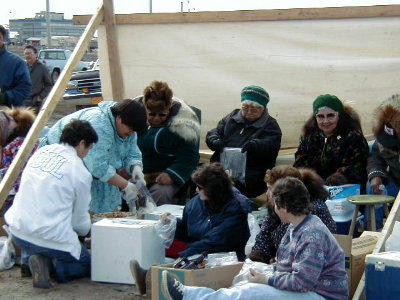
Handing out whale parts at the naluqatak. People bring boxes and plastic= bags to haul home parts of the whale to freeze for later. ____________________________________________________________________ Get your own FREE, personal Netscape WebMail account today at http://webm= ail.netscape.com.
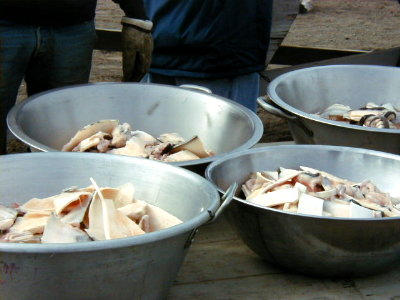
Different parts of the whale: gums, blubber,flukes,meat ____________________________________________________________________ Get your own FREE, personal Netscape WebMail account today at http://webm= ail.netscape.com.

An arctic cod, posing at a hole in the ice (Photo by David Koester) ____________________________________________________________________ Get your own FREE, personal Netscape WebMail account today at http://webm= ail.netscape.com.
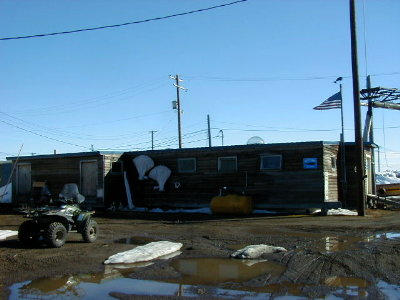
The ARF (Arctic Research Facility), where I stay. ____________________________________________________________________ Get your own FREE, personal Netscape WebMail account today at http://webm= ail.netscape.com.
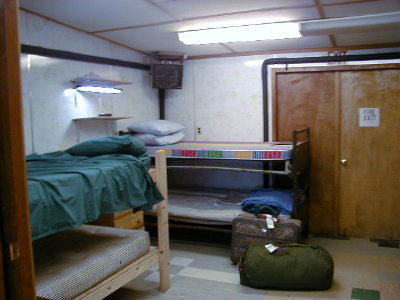
My bedroom in the ARF (Arctic Research Facility). ____________________________________________________________________ Get your own FREE, personal Netscape WebMail account today at http://webm= ail.netscape.com.
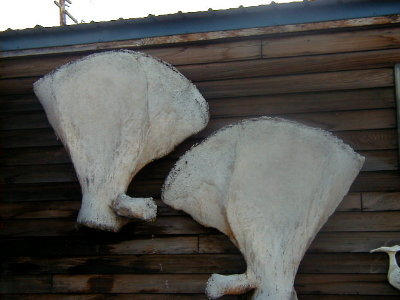
The scapula (shoulder blades) of a bowhead whale. These are hung outside= of the ARF (Arctic Research Facility) ____________________________________________________________________ Get your own FREE, personal Netscape WebMail account today at http://webm= ail.netscape.com.
Contact the TEA in the field at
.
If you cannot connect through your browser, copy the
TEA's e-mail address in the "To:" line of
your favorite e-mail package.
|
